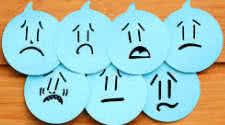The Positive Emotional Benefits Involved in Bodybuilding

There is a reason many athletes experience a positive high through daily exercise.
Emotion can be a driving force in your training, but it can also bring your training to a grinding halt. Negative emotions often lead to irrational training patterns
and overtraining, which naturally lead to injuries. If you recognize yourself in any of the groups or examples described in this column, I advise you to address the
issue now. Otherwise you may well have to stop training altogether or carry a lifelong injury to show for your efforts.
People overtrain for many reasons. Most trainees think that overtraining is something that "other guys do," but if that were true, we wouldn't see so many injuries.
Bodybuilders typically get caught up in overtraining due to lack of knowledge about training methods, confusion about workout programs and even psychological factors,
such as insecurity or the conscious or subconscious need to fulfill an issue.
With hindsight it's easy to see why the first two factors lead to overdoing it. Many trainees start weight training in high school. Since they can't lift heavy weights
or do heavy-volume training at that stage, the issue of overtraining generally does not come up.
As they learn more about what they're doing, the sets and number of exercises (the volume of training), the poundages and the frequency of training all increase. Even
without the other factors, a volume increase demands more recuperation for the muscles and other connective tissues. A high school student who benches 250 pounds and
does not perform much supplemental exercise is going to recover easily. Six years later, when that trainee is on a split schedule, performing 20 sets per bodypart,
and the bench press poundage is in excess of 400, the injuries will begin to accrue. (Poor choice of exercises is another culprit in this type of situation and will
be covered in future columns.) Any mechanical engineer understands the concept of metal fatigue, which means that undue stress put on a structure will cause the structure
to break.
Where does a bodybuilder "learn" how to overtrain like this? Typically, the unfortunate trainee has followed some of the professional bodybuilders' programs that appear
in the muscle magazines, or perhaps he or she has observed the champs working out in the gym. The pros and top amateurs have their share of serious injuries for a variety
of reasons. I cite the following athletes to illustrate the point that it does happen. Remember, these trainees didn't think it would happen to them either. Jeff Everson
tore his pectoralis major while performing his third repetition with 550 pounds in the bench press. Jeff has stated in previous inter-views that he had jet lag at the
time and that, looking back, he should have known better. Rick Valente tore the same muscle after performing a 465-pound bench press on Tuesday and trying to follow it
up with a nearly 500-pound effort on the following Friday. He was dieting down for guest posing at the time of the injury.
Ric Ciotti tore his pectoralis major after handling 405 pounds for 12 to 15 reps followed by 465 for seven reps. When he followed that with 500 pounds, the pec tore. Tom
Beaudette also tore his pectoralis major-he was performing one-arm cable flys one day and heavy bench presses the next.
And the list goes on: Tom Platz, biceps; Ken Waller, triceps; Barry DeMey, pectoralis; powerlifter Roger Estep, pectoralis. They all had to have surgery to reattach the
torn muscle.
The desire and drive that these gentlemen-and you-use can be very positive emotions. How these athletes went about using them is the key issue. Each man was so disciplined
in the sense that the workout or the set or the rep was going to be performed. The discipline was not so great, however, that any of them was able to stop and say, "I
achieved what I set out to do; that is enough for today." change them every month or two to give your subconscious some variety.
The next thing that should be on your bulletin board is your specific goals. Once again, don't go overboard and get your mind confused; "A physique that would scare Sergio
Oliva" is not a realistic goal. Go with items like "17-inch arms," "250-pound bench by Christmas" or "visible gut ruts by summer." These things will help program your mind
to achieve what it sees day in and day out.
Last but not least, a good photo of yourself on the beach or by the pool will do wonders for your inspiration. "Do I really look like that?" You certainly do. That oughta
make you hit the iron with a vengeance!
Training log. So many trainees work out blindly that it's no wonder it takes years for many of them to make noticeable gains in size and strength. By using a training log,
you will minimize the trial-and-error process and make your workout time much more productive. After all, you are a researcher; so log that data!
Keeping a training log isn't a complicated process-no scientific theorems involved. All you need is a stenographer's pad and a pen so that you can write down the weight
and reps of every set. This organized record of your training is a progress monitor that will tell you what's working and what's not. "Is pyramiding my poundages making
me stronger?" Check your training log with a quick flip of the pages.
Remember, organization breeds efficiency, and efficiency in your home gym leads to bigger size and strength gains in less time. You don't have to turn into Felix Unger of
the "Odd Couple," but at least you'll create a home gym you'll be proud to show off. And you might even relieve a little stress from poor old Squat's life in the process.